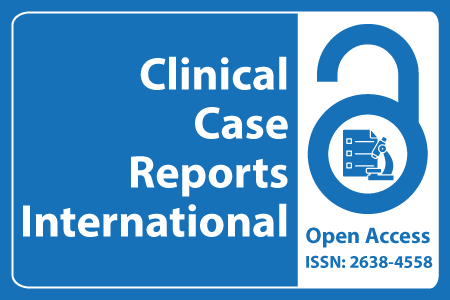
Journal Basic Info
- Impact Factor: 0.285**
- H-Index: 6
- ISSN: 2638-4558
- DOI: 10.25107/2638-4558
Major Scope
- Toxicology
- Pediatrics
- Nutrition and Dietetics
- Cardiac Surgery
- Virology
- Neonatology
- Allergy & Immunology
- Pain Management
Abstract
Citation: Clin Case Rep Int. 2017;1(1):1014.DOI: 10.25107/2638-4558.1014
Outcomes for Endovascular Repair of Infected Abdominal Aortic Aneurysms
Supapong Arworn, Kamphol Laohapensang, Saranat Orrapin and Termpong Reanpang
Department of Surgery, Chiang Mai University Hospital, Thailand
*Correspondance to: Kamphol Laohapensang
PDF Full Text Case Report | Open Access
Abstract:
Aim: We have reviewed our ruptured and non-ruptured infected Abdominal Aortic Aneurysms (AAA) to study the clinical presentation, management and eventual outcome of patients managed with endovascular repair.
Design: A prospective study and analysis of 9 cases treated at a single institution.
Methods: From January 2009 to December 2011, a total of 9 patients with infected AAA underwent Endovascular Aneurysmal Repair (EVAR) at our institution. Six patients were male and 3 were female with the mean age of 67 years (range, 57–83). The diagnosis of infected AAA was determined by clinical evidence of infection (pain, fever and leukocytosis), aortic image, and positive results from blood cultures, pus culture (from CT guide percutaneous and surgical drainage) and Polymerase Chain Reaction (PCR). Empirical parenteral antibiotics were administered on admission. At the time of an operation, all were saccular and 4 of the 9 aneurysms (44.4%) were ruptured (3 contained, 1 free ruptured). All patients have undergone EVAR for AAA; 5 used Bifurcated stent grafts, 2 Tube stent grafts and 2 Aorto-uniiliac stent grafts with femoro-femoral bypass grafting. The parenteral antibiotics were continued in the postoperative period for 4-6 weeks.
Results: Chronic Renal Disease (CRD) was present in 66.66 % (6/9), Coronary Heart Disease (CHD) was present in 55.55% (5/9), Chronic Pulmonary Obstructive Disease (COPD) present in 44.44% (4/9) with diabetes mellitus present in 22.22% (2/9). The most common pathogen was Salmonella species (n =5), Escherichia coli (n =2) and B. pseudomallei (n =2). Forty-four percent (4/9) of the patients presented with ruptured that needed an emergency surgery. There was no 30 days mortality and significant morbidity. Three patients (patient no. 1, 5 and 7) had Infected Stent Grafts (ISG) at 10, 26 and 36 months after EVAR, subsequently received CT-guided percutaneous tube drainage and 2 patients (patient no. 1 and 5) needed later stent graft explantation. One patient (patient no. 7) refused stent graft explantation and died 1 month later at another hospital from gastrointestinal bleeding and septicemia. Conclusions: The immediate results of EVAR for Infected AAA are fair with no 30 days mortality and few complications. The midterm results are not satisfied due to high rate of Infected Stent Grafts (ISG) 33.33% (3/9). EVAR is not a definitive treatment of Infected AAA; it could be a temporizing treatment prior to definitive open surgical repair, or a therapeutic alternative in critically ill patients who may not survive open surgery.
Keywords:
Infected stent grafts; infected abdominal aortic aneurysm; endovascular treatment
Cite the Article:
Arworn S, Laohapensang K, Orrapin S, Reanpang T. Outcomes for Endovascular Repair of Infected Abdominal Aortic Aneurysms. Clin Case Rep Int. 2017; 1: 1014.













